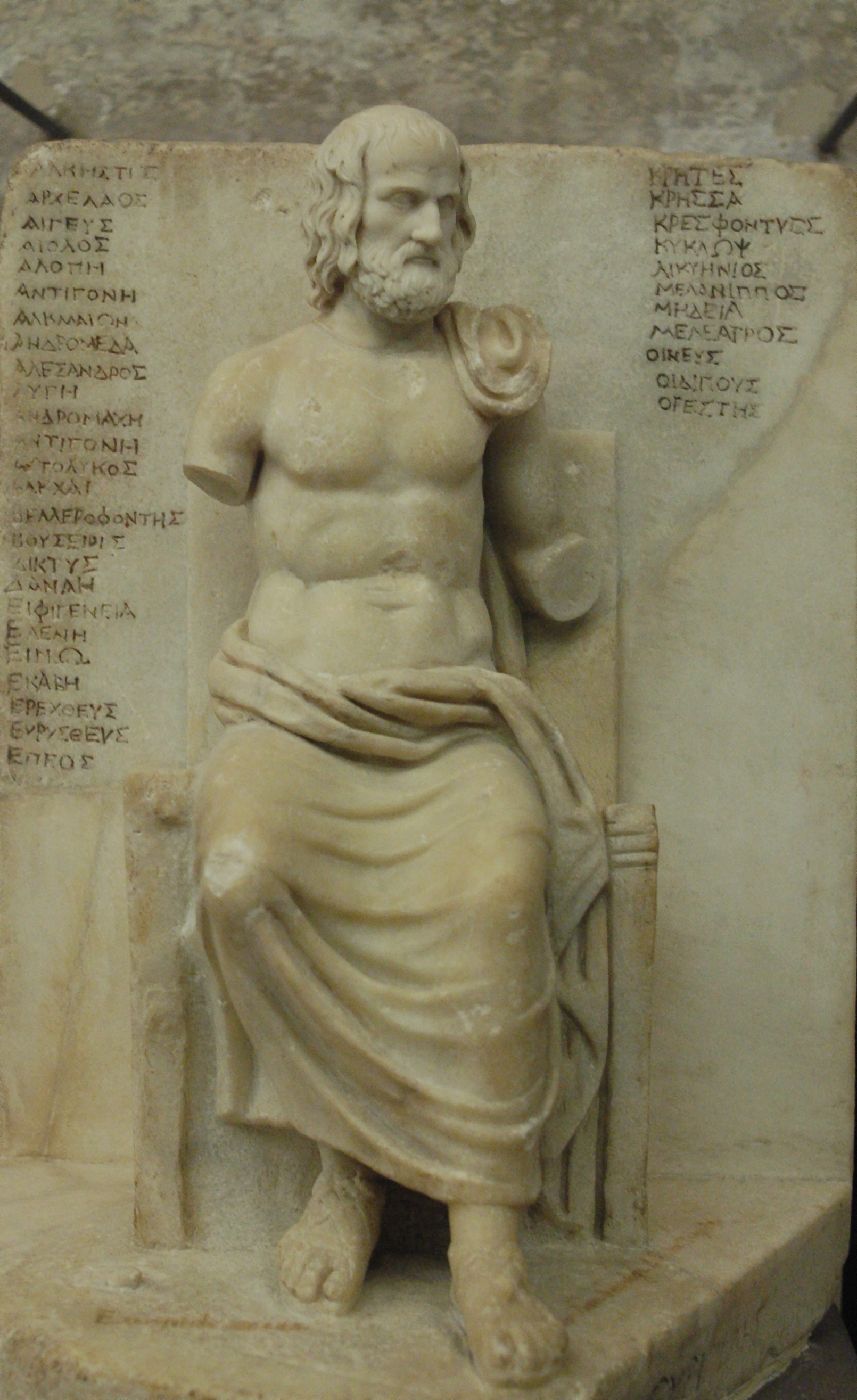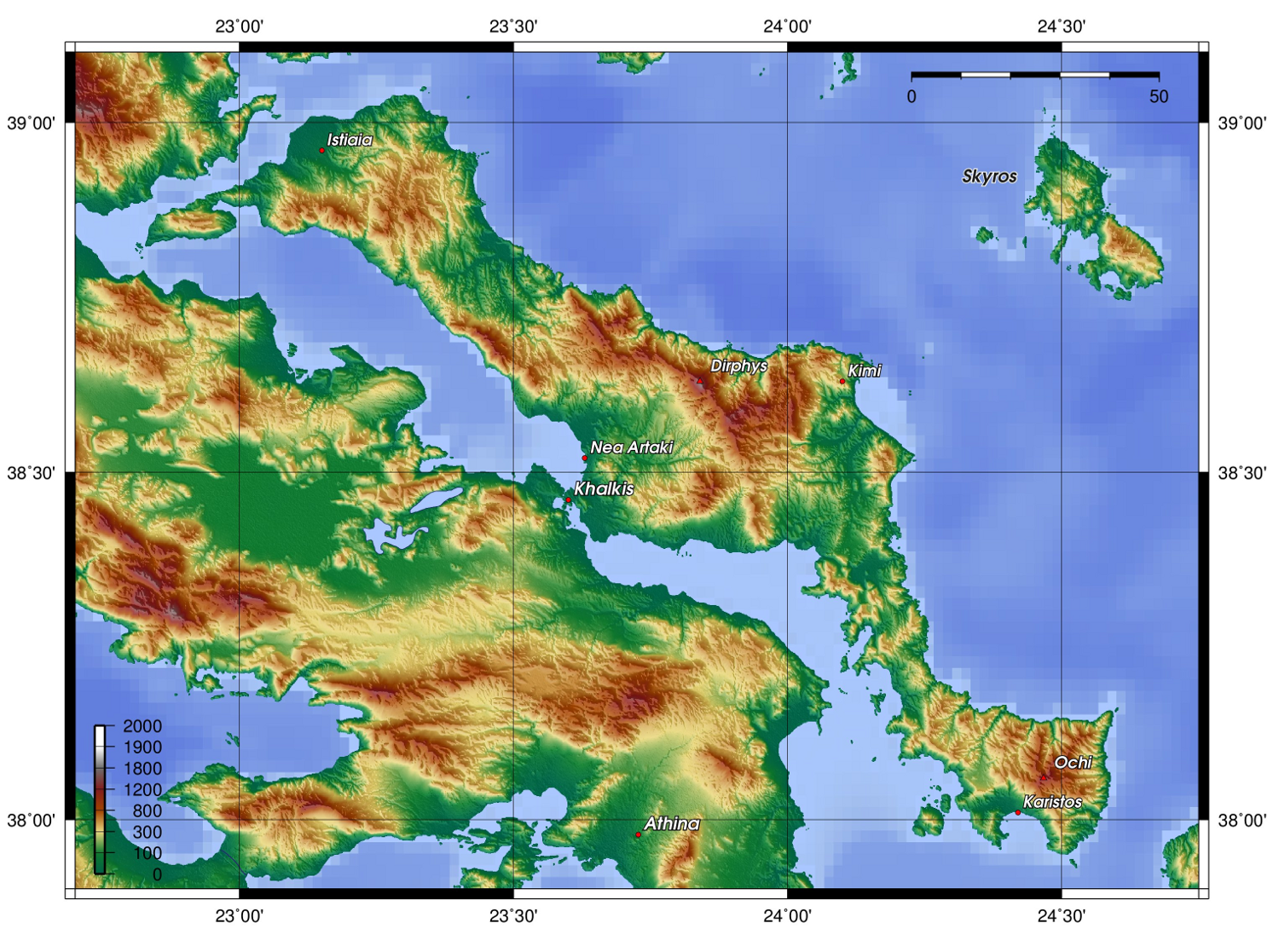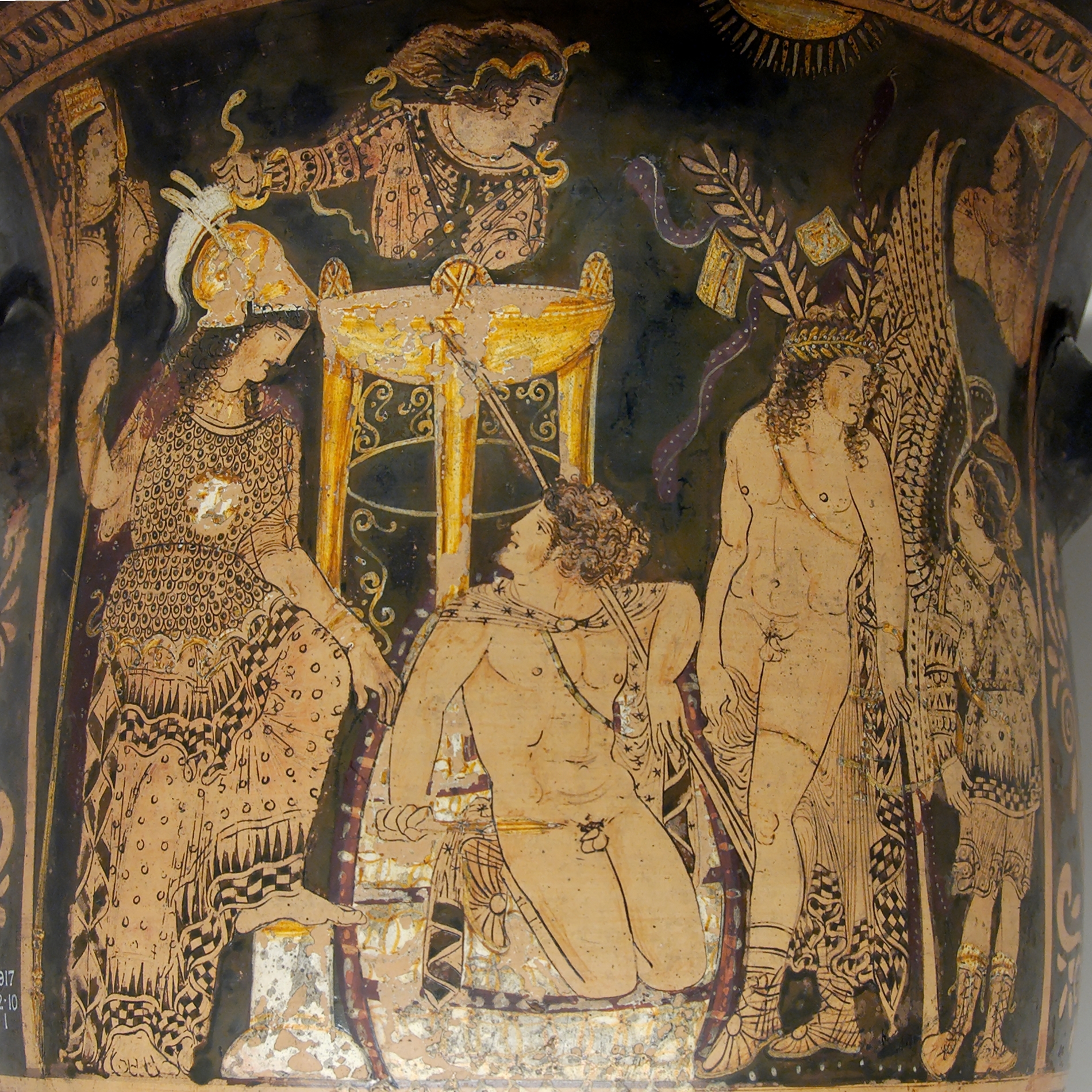|
Halai Araphenides
Halae Araphenides or Halai Araphenides ( grc, Ἁλαὶ Ἀραφηνίδες, Halái Araphenídes) was a deme of ancient Attica, situated on its eastern coast between Brauron and Araphen, and was the harbour of Brauron, whence persons crossed over to Marmarium in Euboea. Etymology The deme draws the first part of its name from the saltiness along the coast, while the second part was introduced to distinguish it from the deme of Halae Aexonides. History Halae was mentioned by Euripides as close to the chain of Karystia. In this place was conserved a statue of Artemis Tauria brought from Tauris by Iphigenia and Orestes. In the deme, expiatory rites were held which consisted of withdrawing drops of blood from the throat of a man by means of a knife; furthermore, they had midnight feasts and Pyrrhic dances. Its port was also used by citizens of a Brauron and for the marble quarries of Karystos, near the island of Euboea, being the closest port of Attica. Location The si ... [...More Info...] [...Related Items...] OR: [Wikipedia] [Google] [Baidu] |
Rafina
Rafina ( el, Ραφήνα) is a suburban port town located on the eastern coast of Attica in Greece. It has a population of 13,091 inhabitants (2011 census). Since the 2011 local government reform it is part of the municipality Rafina-Pikermi, of which it is the seat and a municipal unit. The municipal unit has an area of 18.979 km2. It is part of Athens metropolitan area. Geography Rafina lies on the Aegean Sea coast, east of the Penteli mountains and northeast of the Mesogaia plain. It is north of Artemida, Attica, Artemida, south of Nea Makri and east of Athens city centre. The municipal unit of Rafina contains, besides the city itself, a large portion of the surrounding area, which is mostly woodland and farmland. The only other town is Kallitechnoupoli with a population of 923. The town can be accessed through Greek National Road 54 (Athens – Rafina), Greek National Road 83 (Athens – Marathon – Rafina) and Greek National Road 85 (Lavrio – Rafina). Rafina is a ... [...More Info...] [...Related Items...] OR: [Wikipedia] [Google] [Baidu] |
Euripides
Euripides (; grc, Εὐριπίδης, Eurīpídēs, ; ) was a tragedian Tragedy (from the grc-gre, τραγῳδία, ''tragōidia'', ''tragōidia'') is a genre of drama based on human suffering and, mainly, the terrible or sorrowful events that befall a main character. Traditionally, the intention of tragedy i ... of classical Athens. Along with Aeschylus and Sophocles, he is one of the three ancient Greek tragedians for whom any plays have survived in full. Some ancient scholars attributed ninety-five plays to him, but the ''Suda'' says it was ninety-two at most. Of these, eighteen or nineteen have survived more or less complete (''Rhesus (play), Rhesus'' is suspect). There are many fragments (some substantial) of most of his other plays. More of his plays have survived intact than those of Aeschylus and Sophocles together, partly because his popularity grew as theirs declinedMoses Hadas, ''Ten Plays by Euripides'', Bantam Classic (2006), Introduction, p. ixhe became, ... [...More Info...] [...Related Items...] OR: [Wikipedia] [Google] [Baidu] |
Populated Places In Ancient Attica
Population typically refers to the number of people in a single area, whether it be a city or town, region, country, continent, or the world. Governments typically quantify the size of the resident population within their jurisdiction using a census, a process of collecting, analysing, compiling, and publishing data regarding a population. Perspectives of various disciplines Social sciences In sociology and population geography, population refers to a group of human beings with some predefined criterion in common, such as location, race, ethnicity, nationality, or religion. Demography is a social science which entails the statistical study of populations. Ecology In ecology, a population is a group of organisms of the same species who inhabit the same particular geographical area and are capable of interbreeding. The area of a sexual population is the area where inter-breeding is possible between any pair within the area and more probable than cross-breeding with ind ... [...More Info...] [...Related Items...] OR: [Wikipedia] [Google] [Baidu] |
Geography (Strabo)
The ''Geographica'' (Ancient Greek: Γεωγραφικά ''Geōgraphiká''), or ''Geography'', is an encyclopedia of geographical knowledge, consisting of 17 'books', written in Greek and attributed to Strabo, an educated citizen of the Roman Empire of Greek descent. There is a fragmentary palimpsest dating to the fifth century. The earliest manuscripts of books 1–9 date to the tenth century, with a 13th-century manuscript containing the entire text. Title of the work Strabo refers to his ''Geography'' within it by several names: * geōgraphia, "description of the earth" * chōrographia, "description of the land" * periēgēsis, "an outline" * periodos gēs, "circuit of the earth" * periodeia tēs chōrās, "circuit of the land" Apart from the "outline", two words recur, "earth" and "country." Something of a theorist, Strabo explains what he means by Geography and Chorography:It is the sea more than anything else that defines the contours of the land (''geōgraphei'') and giv ... [...More Info...] [...Related Items...] OR: [Wikipedia] [Google] [Baidu] |
Strabo
Strabo''Strabo'' (meaning "squinty", as in strabismus) was a term employed by the Romans for anyone whose eyes were distorted or deformed. The father of Pompey was called "Pompeius Strabo". A native of Sicily so clear-sighted that he could see things at great distance as if they were nearby was also called "Strabo". (; el, Στράβων ''Strábōn''; 64 or 63 BC 24 AD) was a Greek geographer, philosopher, and historian who lived in Asia Minor during the transitional period of the Roman Republic into the Roman Empire. Life Strabo was born to an affluent family from Amaseia in Pontus (in present-day Turkey) in around 64BC. His family had been involved in politics since at least the reign of Mithridates V. Strabo was related to Dorylaeus on his mother's side. Several other family members, including his paternal grandfather had served Mithridates VI during the Mithridatic Wars. As the war drew to a close, Strabo's grandfather had turned several Pontic fortress ... [...More Info...] [...Related Items...] OR: [Wikipedia] [Google] [Baidu] |
Artemida, Attica
Artemida ( el, Αρτέμιδα, until 1977 ''Loutsa'', el, Λούτσα) is an Eastern suburb of Athens. Since the 2011 local government reform it is part of the municipality Spata-Artemida, of which it is a municipal unit. The municipal unit has an area of 18.653 km2. History The city was named after the ancient goddess Artemis. The Temple of Artemis Brauron was among the most important sacred sites in the ancient times. Vravrona (or Brauron), about 20 km from Athens, was one of the 12 towns of Attica that was united to Athens by Theseus. The ancient temple of Artemis is of Doric style and flourished in the 5th-4th century B.C. According to a myth, this is the temple where Iphigeneia was brought by her brother Orestes, when they met in the land of Tauris, where she served as a priestess in a local temple of Artemis. Iphigeneia had been transferred to Tauris by goddess Artemis herself, when she saved her from the sacrifice in Aulis. Returning to Greece, Iphigeneia br ... [...More Info...] [...Related Items...] OR: [Wikipedia] [Google] [Baidu] |
Euboea
Evia (, ; el, Εύβοια ; grc, Εὔβοια ) or Euboia (, ) is the second-largest Greek island in area and population, after Crete. It is separated from Boeotia in mainland Greece by the narrow Euripus Strait (only at its narrowest point). In general outline it is a long and narrow island; it is about long, and varies in breadth from to . Its geographic orientation is from northwest to southeast, and it is traversed throughout its length by a mountain range, which forms part of the chain that bounds Thessaly on the east, and is continued south of Euboia in the lofty islands of Andros, Tinos and Mykonos. It forms most of the regional unit of Euboea, which also includes Skyros and a small area of the Greek mainland. Name Like most of the Greek islands, Euboea was known by other names in antiquity, such as ''Macris'' (Μάκρις) and ''Doliche'' (Δολίχη) from its elongated shape, or ''Ellopia'', ''Aonia'' and ''Abantis'' from the tribes inhabiting it. Its ancie ... [...More Info...] [...Related Items...] OR: [Wikipedia] [Google] [Baidu] |
Karystos
Karystos ( el, Κάρυστος) or Carystus is a small coastal town on the Greece, Greek island of Euboea. It has about 5,000 inhabitants (12,000 in the municipality). It lies 129 km south of Chalkis. From Athens it is accessible by ferry via Marmari from the port of Rafina. After the Greek war of independence, its urban plan was laid out by the renowned Bavarian civil engineer Bierbach, in the middle of the 19th century. History Karystos apparently remained inhabited throughout the early Middle Ages. As part of the theme (Byzantine district), theme of Hellas (theme), Hellas, it was also seat of a bishop – a suffragan see, suffragan of See of Athens, Athens – at least since the reign of Leo VI the Wise (r. 886–912). It was among the towns listed in the 1198 ''chrysobull'' of Alexios III Angelos, where the Republic of Venice, Venetians were permitted to establish trade stations. In 1205 it was captured, as with the rest of the island, by James II of Avesnes, and soon ... [...More Info...] [...Related Items...] OR: [Wikipedia] [Google] [Baidu] |
Pyrrhic Dance
The Pyrrhichios or Pyrrhike dance ("Pyrrhic dance"; Ancient Greek: πυρρίχιος or πυρρίχη, but often misspelled as πυρρίχειος or πυρήχειος) was the best known war dance of the Greeks. It was probably of Dorian origin and practiced at first solely as a training for war. According to ancient sources, it was a weapon dance. Overview Plato (''Leges'', 815a) describes it as imitating by quick movements the ways in which blows and darts are to be avoided and also the modes in which an enemy is to be attacked. It was danced to the sound of the aulos; its time was quick and light, as is also shown by the metric foot called pyrrhic.The Cambridge Series for Schools and Training Colleges: Xenophon, ''Anabasis'' VI with vocabulary It was described by Xenophon in his work the ''Anabasis''. In that work he writes that the dance was performed at a festival held in Trapezus to celebrate the arrival of the troops in the city. The following is the part in which the ... [...More Info...] [...Related Items...] OR: [Wikipedia] [Google] [Baidu] |
Orestes
In Greek mythology, Orestes or Orestis (; grc-gre, Ὀρέστης ) was the son of Clytemnestra and Agamemnon, and the brother of Electra. He is the subject of several Ancient Greek plays and of various myths connected with his madness and purification, which retain obscure threads of much older ones. Etymology The Greek name Ὀρέστης, having become "Orestēs" in Latin and its descendants, is derived from Greek ὄρος (óros, “mountain”) and ἵστημι (hístēmi, “to stand”), and so can be thought to have the meaning "stands on a mountain". Greek literature Homer In the Homeric telling of the story, Orestes is a member of the doomed house of Atreus, which is descended from Tantalus and Niobe. He is absent from Mycenae when his father, Agamemnon, returns from the Trojan War with the Trojan princess Cassandra as his concubine, and thus not present for Agamemnon's murder by Aegisthus, the lover of his wife, Clytemnestra. Seven years later, Orestes retu ... [...More Info...] [...Related Items...] OR: [Wikipedia] [Google] [Baidu] |
Iphigenia
In Greek mythology, Iphigenia (; grc, Ἰφιγένεια, , ) was a daughter of King Agamemnon and Queen Clytemnestra, and thus a princess of Mycenae. In the story, Agamemnon offends the goddess Artemis on his way to the Trojan War by hunting and killing one of Artemis' sacred stags. She retaliates by preventing the Greek troops from reaching Troy unless Agamemnon kills his eldest daughter, Iphigenia, at Aulis as a human sacrifice. In some versions, Iphigenia dies at Aulis, and in others, Artemis rescues her. In the version where she is saved, she goes to the Taurians and meets her brother Orestes.Evans (1970), p. 141 Name "Iphigenia" means "strong-born," "born to strength," or "she who causes the birth of strong offspring." Iphianassa Iphianassa () is the name of one of Agamemnon's three daughters in Homer's ''Iliad'' (ix.145, 287) The name Iphianassa may be simply an older variant of the name Iphigenia. "Not all poets took Iphigenia and Iphianassa to be two names for the s ... [...More Info...] [...Related Items...] OR: [Wikipedia] [Google] [Baidu] |
History Of Crimea
The recorded history of the Crimean Peninsula, historically known as ''Tauris'', ''Taurica'' ( gr, Ταυρική or Ταυρικά), and the ''Tauric Chersonese'' ( gr, Χερσόνησος Ταυρική, "Tauric Peninsula"), begins around the 5th century BCE when several Greek colonies were established along its coast, the most important of which was Chersonesos near modern day Sevastopol, with Scythians and Tauri in the hinterland to the north. The southern coast gradually consolidated into the Bosporan Kingdom which was annexed by Pontus and then became a client kingdom of Rome (63 BCE – 341 AD). The south coast remained Greek in culture for almost two thousand years including under Roman successor states, the Byzantine Empire (341 AD – 1204 AD), the Empire of Trebizond (1204 AD – 1461 AD), and the independent Principality of Theodoro (ended 1475 AD). In the 13th century, some Crimean port cities were controlled by the Venetians and by the Genovese, but the interior w ... [...More Info...] [...Related Items...] OR: [Wikipedia] [Google] [Baidu] |





.jpg)

